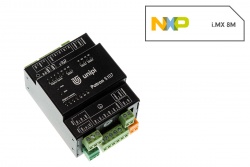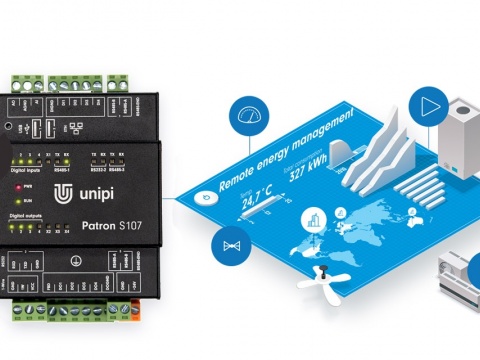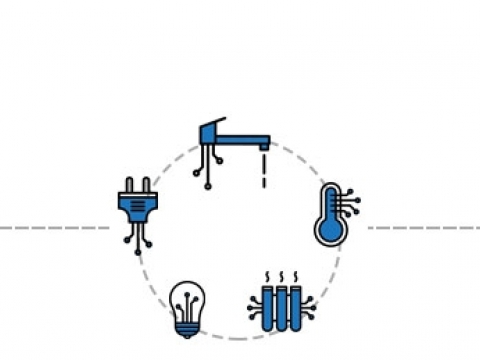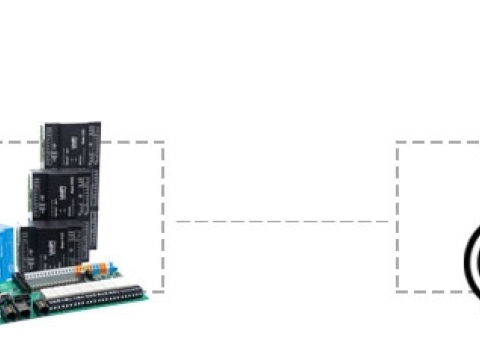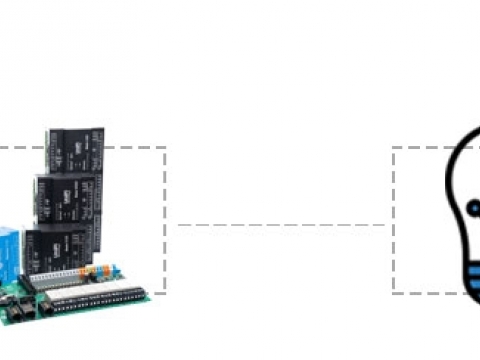
Looking for a way to increase the effectiveness of your business, speed up processes and decrease costs? Automation is the solution, as it opens your business to a whole new world of possibilites ranging from smart heating to intelligent security systems. Unipi technology develops and produces smart open-source programmable logic controllers to power such systems.
Improve your business with automation
Energy consumption monitoring
 Do you own an apartment building, hotel, office building or any other similar facility? Automation can save you a lot of trouble with keeping tabs on the consumption of electricity, water or gas. With a combination of smart meters and a controller, you can have all energy consumption data at hand in your computer, smartphone or tablet. These data can be archived to a cloud database for long-term monitoring; by a simple comparison, you are then able to find space for further improvements (window insulation, economical lighting etc.) or to detect water or gas leaks. That will allow you not only to quickly resolve any issues but also to reduce your expenses by up to 50 %.
Do you own an apartment building, hotel, office building or any other similar facility? Automation can save you a lot of trouble with keeping tabs on the consumption of electricity, water or gas. With a combination of smart meters and a controller, you can have all energy consumption data at hand in your computer, smartphone or tablet. These data can be archived to a cloud database for long-term monitoring; by a simple comparison, you are then able to find space for further improvements (window insulation, economical lighting etc.) or to detect water or gas leaks. That will allow you not only to quickly resolve any issues but also to reduce your expenses by up to 50 %.
Smart surveillance and security

Automation can help you to improve your facility's security. Through an intelligent access system, you will be able to monitor who entered your building and who left it. Smart wireless sensor can constantly monitor the building's surroundings and watch for any trespassers. A smart system can automatically send you a warning message or notify emergency services in case of trespassing, gas leak, fire or any other emergency.
Heating, ventilation, air conditioning (HVAC)

By interconnecting environmental sensors and corresponding devices (thermoelectric radiator valves or ventilation controls), it is possible to automate heating, ventilation and air conditioning systems. HVAC automation will keep the indoor temperature at optimal levels regardless of season or weather. The system can also allow you to set temperature for each room and to disable heating or air conditioning in an unused or empty part of the building. Automation will also significantly improve the ease of facility maintenance and speed up the process of locating and resolving any failures.
Building Management System (BMS)
All above-mentioned automation examples can be combined into a single network. By combining HVAC, smart security and energy monitoring into a single system you can achieve unrivalled savings in both time and money, making the automation a very short-term return investments.
Controlling commercial automation networks

Extensive automation can save you a large amount of both money and time, but that does not mean you have no control over your property. Thanks to a wide range of manual control options it is possible for you or your employees to both control and monitor all connected devices both locally through touchscreen panels or remotely through web interface displayed on tablets, smartphones or computers.
Unipi controllers - the brain of your smart building
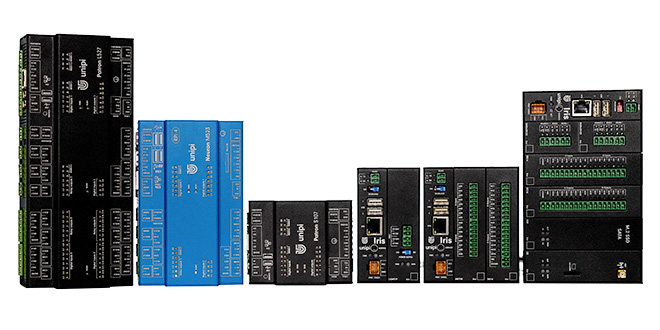
No automation network can function without a controller, serving as a brain of the whole system. PLC receives data from sensors, processes them and then controls and regulates individual system components, serving both as a computing module and as a gateway for other devices. Unipi technology controllers represent a combination of compact size, a high number of I/Os and communication interfaces, and easy installation in distribution boxes by simply mounting the unit onto a standard DIN rail.
Open software
Our main supported platform is the Mervis control software developed under the IEC 61131-3 PLC programming standard. Mervis offers SCADA interface for remote control and monitoring, comprehensible development environment, HMI editor and database for data storage and analysis. Due to a software openness, you are however not limited only to a single software solution; you can use any of our supported platforms instead, including both professional solutions and open-source platforms. Alternatively, you can also implement your code by using our software development kit or our open-source API.
Commercial building automation - where to start?
Step 1: Determining the current building state
If you feel automation is the ideal choice for your project, it is necessary to analyze the current state of your building first. Focus primarily on energy consumption, heating sources, state of ventilation, current heating modes etc. If you are planning a brand-new building, you can skip this step as your project planner probably already took care of it. If you plan the reconstruction of an already existing building, however, you need to go through the following steps:
- calculating energy consumption and expenses (which part of the building consumes most of the energy?)
- energy consumption analysis (which device has the highest energy consumption?)
- heating source analysis (is heating sufficient for the building? Are there issues with underheating/overheating?)
- energy waste analysis (are there any water or gas leaks? Does your building waste energy or heat by heating unused rooms or rooms with open windows?)
You can complete this analysis by yourself, or you can hire any specialised company.
Step 2: Technology replacement
The analysis is followed by more extensive rebuilding based on gained data. This phase usually consists of the replacement of old worn-out boilers, installation of new lighting switches and sensors, replacement of older AC units etc.
Step 3: Controller installation
when choosing the particular model of PLC, your choice should be based on devices you want to control; various components such as external relays, digital switches, smart energy meters or touchscreen panels require different I/Os or communication interfaces to function properly. We also recommend to always plan for more I/Os than is immediately needed to avoid any potential unpleasant surprises during the installation. By creating an I/O reserve you also gain space for future extension of your network.
Show controllers on the e-shop
Commercial buildings automation DIY
If you decided to install the automation network by yourself, you will need at least four people - project designer, energy technician, control software programmer, or additionally a user interface developer.
- project designer will draft the system design, determine the type and number of required components and will calculate project costs
- energy technician is responsible for physical installation and connection of all components
- control software programmer will program all system tasks using the preferred software platform or by implementing custom code.
- if the project requires a control interface, the interface programmer can create a web control interface to allow both property owner and employees an easy system control and management.
The Unipi technology team provides customer support in all above-mentioned phases. Technicians can consult our technical support provided for all Unipi products, while programmers have the option to visit one of our periodic Mervis training courses. Mervis represents a fully standardised platform to which we provide both technical support and all necessary manuals and tutorials.
Installation companies
Don't have time or capacity for installing the system by yourself? Choose an installation firm! We are partnered with many installation companies across the globe - just choose from our list and the company will take care of the rest.
